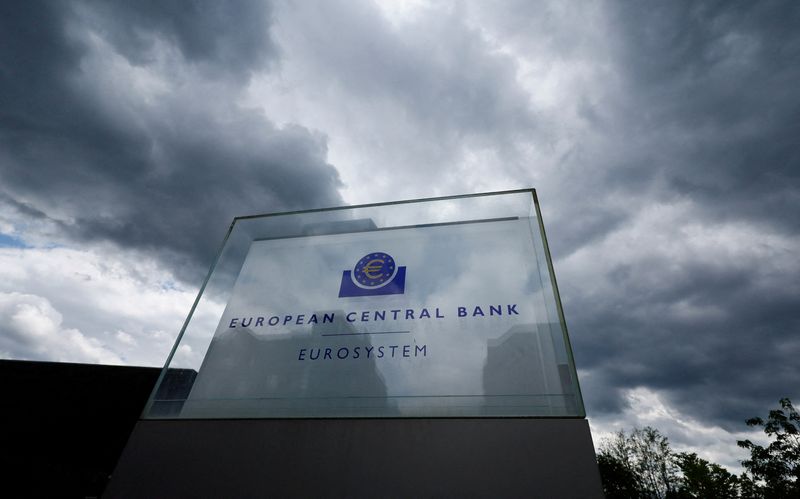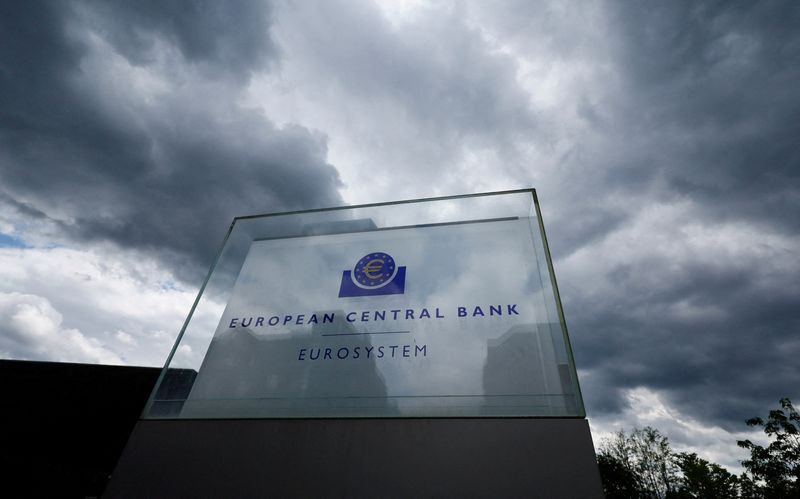
By Balazs Koranyi and Francesco Canepa
FRANKFURT (Reuters) – The European Central Bank is all but certain to cut interest rates again on Thursday and signal further easing in 2025 as inflation in the euro zone is nearly back at its target and the economy is faltering.
The ECB has already cut rates at three of its last four meetings. Debate has nevertheless shifted to whether it is easing policy fast enough to support an economy that is at risk of recession and facing political instability at home and the prospect of a fresh trade war with the United States.
That question is likely to dominate Thursday’s meeting but policy hawks, who still command a comfortable majority on the 26-member Governing Council, are likely to back just a small cut of 25 basis points, taking the benchmark rate to 3%.
In a possible compromise with more dovish policymakers, the cut could come with tweaks to the ECB’s guidance to make clear that further policy easing is coming provided there are no new shocks to inflation, which could hit the central bank’s 2% target in the first half of 2025.
“Fundamentals fully justify the December cut and a more dovish forward guidance, given the deterioration in the growth picture. Underlying inflationary pressures have eased and risks of further headwinds to growth have increased after the U.S. election results,” Annalisa Piazza at MFS Investment Management said.
A cut is warranted because fresh projections will show inflation, above target for three years now, back at 2% in a few months’ time. That is partly because economies are barely growing across the 20 countries that share the euro.
The outlook is so fraught with risk that some policymakers argue the ECB now risks undershooting its inflation target, as it did for nearly a decade before the pandemic, and should move more quickly to avoid falling behind the curve.
But hawks say inflation is still a risk given rapid wage growth and the fast-rising cost of services, so that a steady stream of incremental steps is appropriate.
U.S. protectionism and political instability in France and Germany are further reasons for caution.
Governing Council members simply do not know what policies will be approved by president-elect Donald Trump’s new U.S. administration, how Europe will respond – or what the economic impact will be.
Political turmoil in France and Germany’s upcoming election add to the uncertainty and could force the ECB to step in, reinforcing arguments that it should leave itself space to take bold action if needed.
“The risk of a confidence crunch that could yet lead to a much steeper downturn in France, spreading through the euro zone via trade links, has inevitably risen,” Sandra Horsfield at Investec (LON:INVP) said.
“Keeping powder dry for such an eventuality might be wise. Besides, a steep cut now might fan rather than ease market qualms,” she added.
STRING OF CUTS
Financial markets have fully priced in a 25 basis point rate cut on Thursday, with the odds of a bigger step now close to zero – a big change from a few weeks ago when a half percentage point cut was seen as a real possibility.
Investors then see a cut at every meeting until June, followed by at least one more cut in the second half of 2025, taking the deposit rate to at least 1.75% by year-end.
Any change in the ECB’s guidance for the future is likely to be at the margins.
It could drop its reference to needing “restrictive” policy to tame inflation, an implicit signal that rates will come down at least to the so-called neutral level at which they are neither stimulating nor slowing economic activity.
The problem is that neutral is an undefined concept and each policymaker has a different estimate, putting the range between 1.75% and 3%, with most seeing it between 2% and 2.5%.
But the ECB is likely to keep its intentions vague after having burned itself repeatedly by making explicit commitments that proved difficult or impossible to keep.
“Given the massive international geopolitical and policy uncertainty, the ‘data-dependent and meeting-by-meeting approach to determining the appropriate level and duration of restriction’ is still appropriate,” Lorenzo Codogno at LC Macro Advisors said.

